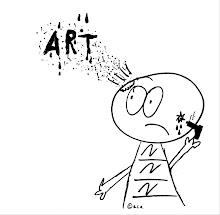In my previous post I was blithering away about film and reality in film. I had insinuated there is no true reality in film. Just films trying to get as close to possible at a certain reality. And I proposed the filmmaker best at this was and still is Stan Brakhage. I use both past and present tense there; because Stan is dead. But his nearly 380 films which range in length from a few seconds to many hours are still the most intense, original and real body of work that any director has come up with to date.
A little back ground might be needed for people unfamiliar with Stan Brakhage's films. And most people have never heard of him, even though he is considered one of the most important and influential experimental and documentary filmmakers in the history of cinema.
Stan was born in 1933 and died in 2003. He briefly attended college and then dropped out and started to hang out with other beat poets. But Stan quickly became what consider a visual poet. Almost all his films lack any narrative story, script or actors. Instead they are akin to poetry or music. All though Stan would say his films are mostly documentaries. Stan tried through camera movement, editing, trick photography and hundreds of other cinema devices to mimic what his mind and eyes "saw" not only emotionally but visually.
Stan was one of the few originals in cinema. Stan was so taken by film that he worked on a film almost everyday of his life. And he rarely got paid for it. Almost all of is 380 plus films are self financed. No studios, no producers, not even a lot grants. Stan made films cause he had too. He wanted no intrusion on his "vision", after all he was trying to closely capture what HE saw and felt. A true auteur.
Stan's first films had the same rhythms of beat poetry. But he soon developed a new cinematic language that was polar opposite of D.W. Griffiths narrative aesthetic. After WW II movies were still weighted down by sound recording. Previous to sync sound recording in the late 1920's cameras had the freedom to go anywhere, move any direction. But the advent of sound had literally locked them in a box. Stan freed the camera from sound again and made a whole new moving camera language. His style soon got ripped off and is still being ripped off.
After the early poetic films Stan took his new aesthetic and applied it to home movies filming his wife, children and pets. He was one of the first person to ever make a home movie about child birth. And his film WINDOW WATER BABY MOVING is no, daddy in the waiting room film, this is the true birthing process. This film is more bloody than any of the franchises of Friday the 13th. And when Stan ran out of money and film, he still made films. Literally taking all the bits of moths from his cabins light fixtures and gluing them piece by piece frame by frame onto clear film leader to make an animated film, MOTHLIGHT, which one might call a documentary on the life span of a moth from birth to scorching death.
Stan and D.W. Griffith are perhaps the most ripped off filmmakers of all time. Directors from Martin Scorsese to David Fincher cite Stan as an influence.
Even though he never made a film for a studio or with an actor spouting scripted dialogue the Academy of Motion Picture Arts and Sciences, who know the Oscar people who love big name actors, are wisely restoring and archiving all of Stan's films.
Some of Stan's films are available on Criterion on a 2 disc DVD set and word has it another 3 disc set in underway. But watching Stan's films on dvd is like watching Lawrence of Arabia on a tv, it misses the point. So if your local art house cinema, museum or college is showing any of his films, I recommend it.
More in a later post on how Stan Brakhage altered the way I think. And I don't mean just psychologically, I mean physically altering my brain as well.


Who wants to watch a too-long, psychedelic, gore film (of a woman giving birth) with their brother? That was a bit odd, but I do love that film. It was excruciatingly uncomfortable to watch, even though it shows the birth of life. Many people enjoy horror scenes of death and mutilation in film, but get squeamish during 'depictions' of birth. For that reason, birth is often portrayed with the same annoying, generalized comedy routine. Could it be that people are more horrified by birth than death? I like the questions and feelings WINDOW WATER BABY MOVING inspires.
ReplyDeleteI want to tell you that when -that car was flying through the air, upside down, I knew I was going to live.
Who wants to watch a too-long, psychedelic, gore film (of a woman giving birth) with her brother? That was a bit odd, but I do love that film. It was excruciatingly uncomfortable to watch, even though it shows the birth of life. Many people enjoy horror scenes of death and mutilation in film, but get squeamish during 'depictions' of birth. For that reason, birth is often portrayed with the same annoying, generalized comedy routine. Could it be that people are more horrified by birth than death? I like the questions and feelings WINDOW WATER BABY MOVING inspires.
ReplyDeleteI want to tell you that when -that car was flying through the air, upside down, I knew I was going to live.
Love, Christine